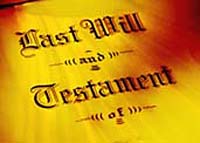
A last will and testament is a legal document that distributes assets, including investments, real estate and personal property after death. Once a will has been signed and executed, it becomes the foundation for an estate plan. However, what happens if you want to make changes? This is the topic addressed in a recent article from smartasset.com, “What is a Codicil to a Will?”
A codicil is a legal document that changes an already completed and valid will. Some prefer to use a codicil rather than revise their entire will, usually for reasons of economy. The codicil allows the will’s creator to update specific provisions. A codicil can be used to change beneficiaries, assign a different person to be the estate executor, or even change the size of gifts made to heirs.
Codicils are like wills: they need to be signed and witnessed according to the laws of the state to be valid. People like the ability to make changes to their wills quickly and easily. However, sometimes, a codicil is not the right way to change a will.
The codicil performs best when changes being made to the will are minor in nature. They should be used to make small changes when the testator’s wish is to maintain the overall intent of the will. For instance, the birth of a new child and the addition of an heir could be reflected through a codicil.
An experienced estate planning attorney must create the codicil. Making a note on an original will with initials and a date is not a codicil. It’s a separate document, requiring a formal signature and the presence and signatures of witnesses. Most states don’t require a codicil to be notarized. However, you should check with your estate planning attorney to find out if this applies to your state.
Making a lot of changes to a will with multiple codicils may result in estate problems in the future. There are numerous instances where multiple changes, especially repetitive ones, like taking the same person off and then adding them back, are perceived as changing the intent of the testator (the person who made the will). This leaves the entire estate vulnerable to challenges.
Some typical reasons for using a codicil:
Before having your estate planning attorney create a codicil, there are a few steps to take. First, discuss the reason for the change and whether the entire will should be revised. A new will may be better if the change is not simple and straightforward. If the codicil is being done to disinherit a beneficiary, your estate planning attorney may have other suggestions. If you have created trusts, the changes to the will don’t carry over to your trusts. They may need to be modified as well.
Reference: smartasset.com (Oct. 23, 2024) “What is a Codicil to a Will?”
